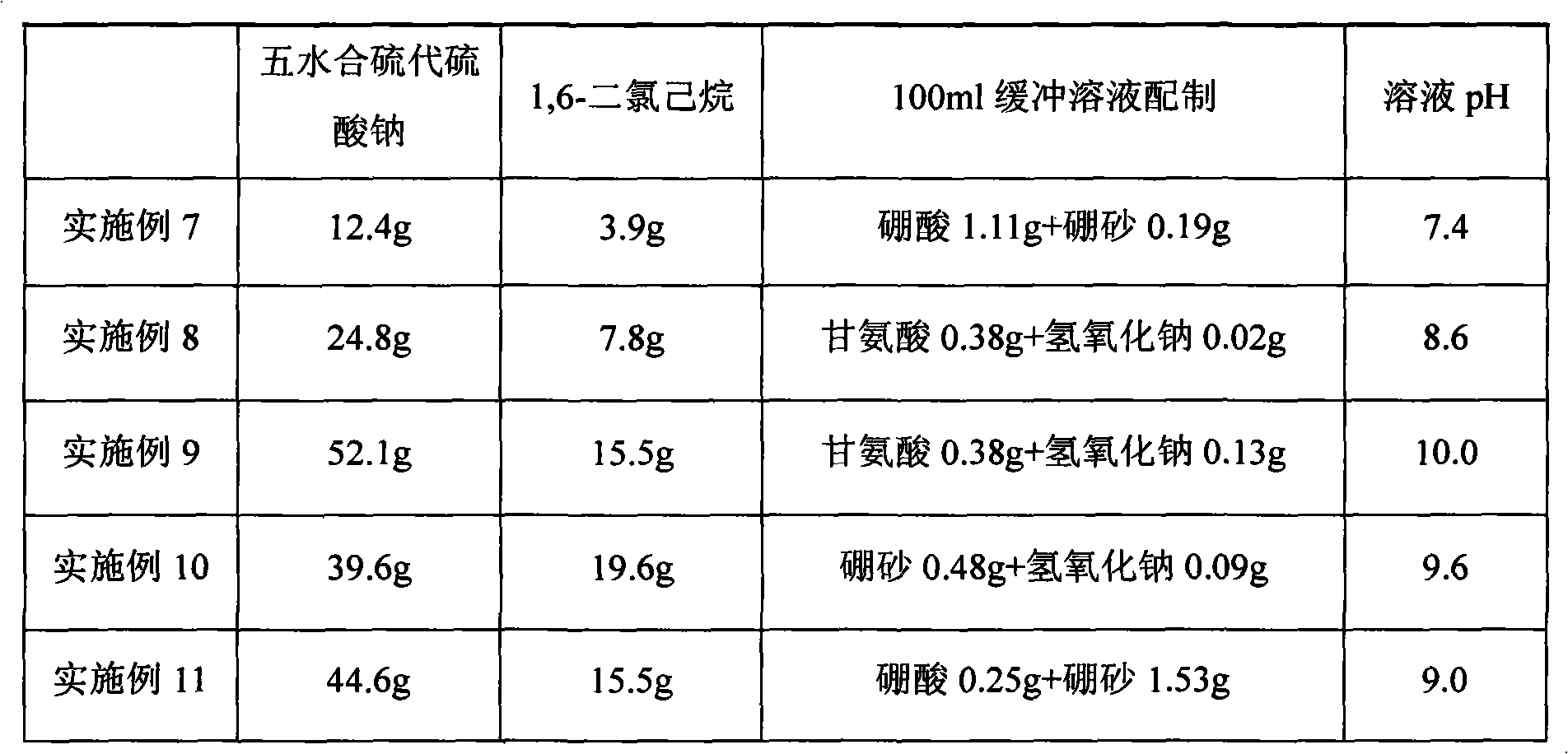Preparation method of thiosulfuric acid derivative for rubber industry
A technology of thiosulfuric acid and the rubber industry, which is applied in the field of preparation of thiosulfuric acid derivatives for the rubber industry, can solve the problems of reducing the safety of the production process and the volatilization of organic solvents, and achieve the solution of acidification of the solution, improvement of product purity, The effect of improving safety
- Summary
- Abstract
- Description
- Claims
- Application Information
AI Technical Summary
Problems solved by technology
Method used
Image
Examples
Embodiment 1
[0024] A 200mL four-necked flask equipped with a mechanical stirring device, a thermometer and a reflux condenser was used as a reaction vessel, and 0.42g of sodium bicarbonate and 0.04g of sodium hydroxide were weighed, and 110mL of water was added to prepare a sodium bicarbonate with a pH value of 9.6- Sodium hydroxide buffer solution was placed in a reaction vessel, 13.6g of sodium thiosulfate pentahydrate was weighed, added to the above solution, after mechanical stirring to dissolve, 6.7g of 1,6-dibromohexane was added while stirring, and the temperature was heated. For the above solution, the temperature of the reaction solution was raised to 102 °C, and after stirring the reaction for 5 h under reflux conditions, the solution was poured out and 110 mL of ethanol was added. After drying, hexamethylene dihydrate 1,6-dithiosulfate disodium salt is obtained.
Embodiment 2
[0026] A 200mL four-necked flask equipped with a mechanical stirring device, a thermometer and a reflux condenser was used as a reaction vessel, and 0.42g of sodium bicarbonate and 0.04g of sodium hydroxide were weighed, and 110mL of water was added to prepare a sodium bicarbonate with a pH value of 9.6- Sodium hydroxide buffer solution was placed in a reaction vessel, 23.6g of ammonium thiosulfate was weighed, added to the above solution, after mechanical stirring to dissolve, 12.4g of 1,6-dichlorohexane was added while stirring, and the above solution was heated with temperature , the temperature of the reaction solution was raised to 80 °C, and after stirring the reaction for 6 h under reflux conditions, the solution was poured out and 200 mL of ethanol was added. That is, hexamethylene dihydrate 1,6-dithiosulfate diammonium salt is obtained.
Embodiment 3
[0028] A 200mL four-necked flask equipped with a mechanical stirring device, a thermometer and a reflux condenser was used as a reaction vessel, and 0.42g of sodium bicarbonate and 0.09g of sodium hydroxide were weighed, and 110mL of water was added to prepare a sodium bicarbonate with a pH value of 10.0- Sodium hydroxide buffer solution was placed in the reaction vessel, 69.5g of sodium thiosulfate pentahydrate was weighed, added to the above solution, after mechanical stirring to dissolve, 24.1g of 1,6-dichlorohexane was added while stirring, and the temperature was heated. For the above solution, the temperature of the reaction solution was raised to 90 °C, and after the reaction was stirred for 9 h under reflux conditions, the solution was poured out and 600 mL of ethanol was added. After drying, hexamethylene dihydrate 1,6-dithiosulfate disodium salt is obtained.
PUM
 Login to View More
Login to View More Abstract
Description
Claims
Application Information
 Login to View More
Login to View More - R&D
- Intellectual Property
- Life Sciences
- Materials
- Tech Scout
- Unparalleled Data Quality
- Higher Quality Content
- 60% Fewer Hallucinations
Browse by: Latest US Patents, China's latest patents, Technical Efficacy Thesaurus, Application Domain, Technology Topic, Popular Technical Reports.
© 2025 PatSnap. All rights reserved.Legal|Privacy policy|Modern Slavery Act Transparency Statement|Sitemap|About US| Contact US: help@patsnap.com

